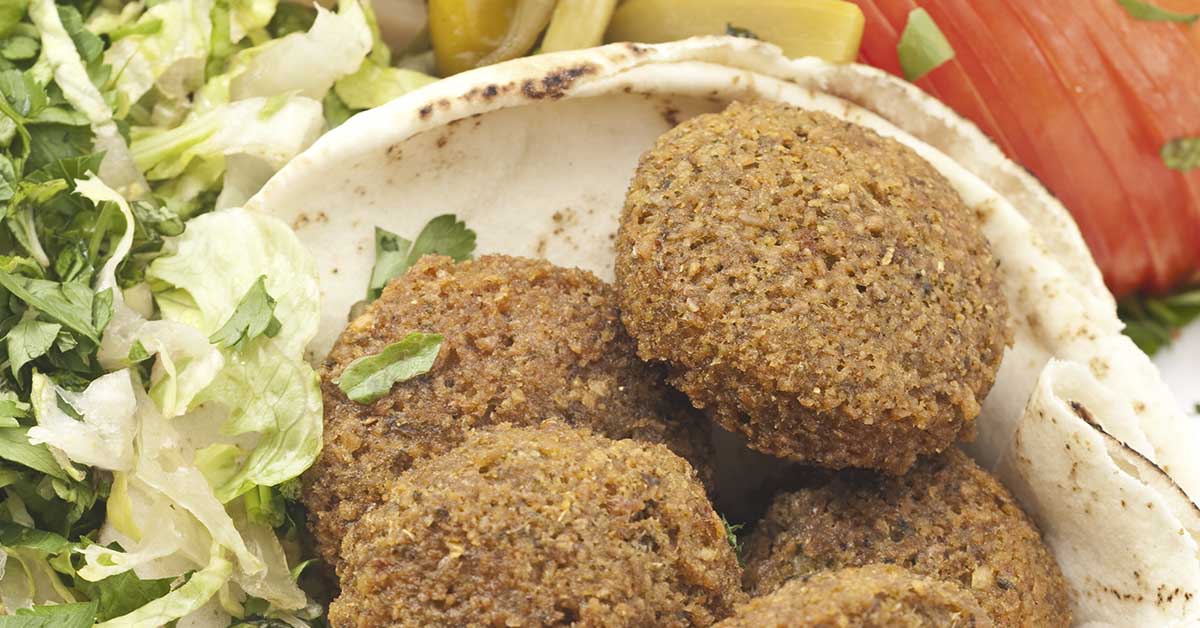Falafel is a popular Middle Eastern street food that’s enjoyed by food lovers all over the world. Falafel is made of chickpeas or fava beans ground up, shaped into balls or patties, and fried. It’s often served as a sandwich, with the falafel balls placed in a pita or wrapped in a flatbread along with salads, vegetables, hummus, and tahini sauce. It’s a naturally vegetarian and vegan dish (unless served with dairy sauces or similar additions.) So the question arises: Is falafel healthy?
The Benefits of Chickpeas and Fava Beans
The main ingredients in falafel are legumes, whether it’s chickpeas or fava beans. Legumes contain many health benefits. For instance, they are high in protein, making them a favorite for vegans and vegetarians. They are also low in saturated fat, and rich in vitamins like iron, magnesium, copper, B vitamins, phosphorus, zinc, and manganese.
Plus, they are an excellent source of dietary fiber, which is vital in many bodily functions, from helping bowel movements and digestive health, maintaining healthy cholesterol levels, and controlling blood sugar levels. Fiber also helps people feel properly satiated after a meal, which can prevent overeating and lead to weight loss. Legumes in general are apt at maintaining healthy cholesterol levels and blood sugar levels. [1]
Chickpeas in particular (also called garbanzo beans) are nearly complete proteins and are high in lysine. They are also high in vitamin A, E, and C, as well as potassium and folate. Chickpeas are low in sodium (although the canned versions are generally high in it. But rinsing canned chickpeas can reduce the sodium content.) [2] Even when eating falafel made of fava beans, you can enjoy these benefits if you eat it with the common addition of hummus, which is made of chickpeas, olive oil, and tahini.
Meanwhile, fava beans have their own individual benefits, including nutrients like folate, potassium, calcium, and thiamine. They also contain antioxidants that can support the immune system. The manganese and copper in the beans could contribute to good bone health, and the iron content can help alleviate symptoms of anemia. [3]
Read: 11 Foods That Stay Good After Their Expiration Date
How to Make Healthy Falafel
So the main ingredient in falafel is healthy, but other components of the dish may not be, especially considering the sandwich as a whole. For instance, additions often include sauces and pickles that are high in salt and sodium. Plus, people with sesame allergies might avoid restaurant falafels because they are likely to contain tahini. But the most glaring concern is that falafel balls are typically deep-fried to achieve their crunchy, tasty exterior.
However, deep-frying is famously unhealthy. For one thing, fried foods are higher in calories and fat compared to other cooking methods. They are also likely to contain trans fats, which are associated with an increased risk of conditions like heart disease, diabetes, and obesity. In fact, eating a lot of fried foods, in general, can contribute to a higher risk of these conditions. [4]
Fortunately, most health issues with falafel could be avoided by making it yourself at home. Namely, you could bake or air-fry the falafel and reduce the salt content by choosing low-sodium ingredients. You can use whole wheat pitas instead of white, or even skip the bread altogether and make a falafel platter with an array of salads, cole slaws, roasted vegetables, hummus, babaganoush, and tahini. Plus, making them at home reduces the risk of any allergic reactions. Here’s a healthy baked falafel recipe to try from Tom Kerridge on BBC Food. [5]
Ingredients
- 1 tsp olive oil
- 2 small onions (200g/7oz total), finely chopped
- 2 (400g) cans of chickpeas, rinsed and drained
- 4 garlic cloves, grated
- 3 tsp ground cumin
- 2 tsp ground coriander
- 2 tsp sea salt flakes
- 30g/1oz coriander leaves, roughly chopped
- 30g/1oz flat-leaf parsley leaves, roughly chopped
- 40g or 1½ oz flour (can be swapped with all-purpose gluten-free flour)
- freshly ground black pepper
- olive oil spray
Directions
- Preheat the oven to 450 degrees Fahrenheit or 210 degrees Celsius, and line a baking tray with baking parchment.
- Heat the olive oil in a small frying pan over medium heat.
- Add the chopped onions and cook for about 10 minutes, or until the onions have softened and are starting to brown. (Add a splash of water to the pan if they start to stick).
- Remove the pan from the heat and let it cool.
- Place the onions, chickpeas, garlic, spices, salt, chopped herbs, flour, and some pepper into a food processor.
- Pulse until the batter is fairly smooth, pausing occasionally to scrape down the sides. You don’t want the mixture to be completely blended. Be sure to retain some texture but it should be able to hold together.
- Divide the batter into 18 equal pieces and shape into patties.
- Place each one on the prepared baking tray and spray them with 10 sprays of olive oil.
- Bake them on the top shelf of the oven for 20–25 minutes, or until golden-brown.
- You can flip the patties halfway through to brown on both sides.
Click here for the original recipe, along with Kerridge’s recipe for tzatziki sauce to pair with it.
Keep Reaidng: Why the Government Controls the Color of Our Food
Sources
- “Are There Health Benefits of Falafel?” WebMD. Dan Brennan, MD. October 25, 2021
- “What Are Chickpeas and Are They Healthy?” Cleveland Clinic. January 13, 2022
- “10 Impressive Health Benefits of Fava Beans.” Healthline. Lizzi Streit, MD, RDN, LD. December 6, 2018
- “Why Are Fried Foods Bad For You?” Healthline. Kayla McDonnel, RD. November 19, 2017
- “Healthy baked falafel.” BBC Food. Tom Kerridge.

